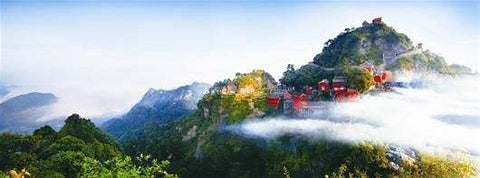Wudang Mountains are one of the most famous Daoist holy mountains in China. The palaces and temples on Wudang Mountains were all built into the actual mountain face, adhering to the topography of the land, which dictated the scale of the buildings, the spaces between them and their layout. Palaces appear on the tops of peaks, in the middle of ravines, on the edges of cliffs and nestled within rock faces.

Apart from its unique architecture, Wudang is renown for its wealth of cultural relics.Throughout its history, but most especially during the Ming Dynasty, Wudang was the recipient of numerous religious gifts. Feudal rulers and Taoist devotees provided funds for the molding of thousands of statues of gods and the crafting of thousands of musical instruments made of gold, silver, copper, iron, tin, jade, pearl and stone.
The first temples on Mount Wudang were constructed during the Tang Dynasty (AD 618-907). By that time Taoism had become a state religion, coexisting with both Buddhism and Confucianism as one of the three great religions of China. Taoism is essentially a reinterpretation of an ancient tradition of nature worship and divination. Taoists believe that the Dao (or Tao , meaning "way" or "path") is the origin of all creation and the force behind all the changes in the natural world. Simplicity, harmony, peace and retreat into nature are some of the basic principles of Taoism.
Taoist culture has existed on Mt. Wudang since the East Han Dynasty (AD 25-220).The movement began with a few early Taoists settling on the mountain in order to practise their worship of nature. As time passed, more Taoists converged on the mountain, making Mt. Wudang a Taoist holy place in central China. During the Zhenguan period (AD 627-647) in the Tang Dynasty Emperor Taizong constructed the Wulong (Five Dragons) Temple , the purpose of which was to spread Taoism on the mountain. The temple structure is one of the ways of expressing Taoist culture in physical form. A temple provides a container for the integration of the various elements of Taoism. Mt. Wudang remained a sacred Taoist site for several hundred years. The buildings were enlarged during the Song and Yuan Dynasties, but many of the buildings from this period were destroyed during warfare and battles at the end of the Yuan Dynasty when the Mongols invaded China.
The greatest period of development was during the Ming Dynasty (AD 1368-1644). In AD 1413 Emperor Yongle (AD 1403-1424) sent more than 200,000 soldiers and laborers to transform Mt. Wudang into the largest Taoist complex in the world. It took thirteen years to complete construction, which included nine palaces, seventy-two temples and halls, thirty-six nunneries, thirty-nine bridges, twelve platforms and countless stone steps winding their way along the entire mountain. The floor space of all of these complexes came to over one million square meters, although now, with the destruction of many buildings the floor space totals 50,000 square meters. In 1994 the ancient building complex in the Wudang mountains was inscribed as a World Heritage Site by UNESCO.
Wudangshan is located in a quite mild area of China. The Temperature in the summer usually dos not rise over 37 degree, while in the winter it will not sink under -5 degree. It is a very green mountain with a vast flora and also fauna. Therefor it has since ancient times always attracted people, who want to practice Martial Arts, meditation or any other kind of self cultivation or arts.

 Nothing will be posted on your behalf.
Nothing will be posted on your behalf.

